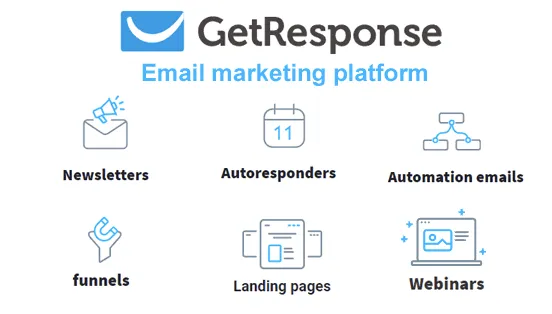12 Effective Newsletter Design Tips for Beginners (& Examples)

Disclosure: Some of the links in this article may be affiliate links, which can provide compensation to me at no cost to you if you decide to purchase. This site is not intended to provide financial advice and is for entertainment only.
Email newsletters are an effective way to connect with your audience and keep them informed about your business. But designing a newsletter that is both visually appealing and engaging can be a challenging task, especially for beginners. In this blog, we will cover the basics of creating an effective email newsletter. We will discuss the importance of email newsletters in digital marketing and their advantages and disadvantages. We will also provide tips on how to establish your goals and objectives, choose the right platform, build your subscriber list, segment contacts for better targeting, and design engaging content. Additionally, we will talk about how to optimize your email newsletter over time by understanding email metrics, determining the best time to send your newsletter, and improving click-through rates. Lastly, we will share some inspiring examples of successful newsletter designs and introduce you to some helpful tools like Photoshop, Canva, Figma, Visme, and GetResponse that can simplify your design process.
Understanding Email Newsletters
Email newsletters play a crucial role in digital marketing strategies, allowing businesses to engage with their audience and establish strong relationships. By providing relevant and valuable content, newsletters can drive traffic to websites and increase conversions. Personalization and segmentation are key factors that contribute to the effectiveness of email newsletters. By tailoring content based on recipient preferences and behaviors, businesses can deliver targeted messages that resonate with their audience. Tracking and analyzing metrics such as open rates, click-through rates, and conversions provide insights into the success of newsletters and help guide future improvements. With HTML and responsive design, newsletters can be optimized for viewing on different devices, including mobile. Integrating social media links and sharing buttons encourages engagement and expands reach. By understanding the best time to send newsletters and continuously refining their content, businesses can create click-worthy and effective email newsletters.
Importance of Email Newsletters in Digital Marketing
Email newsletters play a crucial role in digital marketing strategies. They offer a cost-effective way to communicate directly with potential customers, establishing brand identity and increasing brand awareness. By promoting products, services, and special offers, newsletters provide a platform to engage with subscribers. Building an email list through newsletters enables businesses to reach a targeted audience, ensuring their messages are delivered to those most interested. Additionally, newsletters can be designed using responsive HTML templates, ensuring they are mobile-friendly and accessible on any device. This enhances the user experience and increases the likelihood of engagement and conversions. Sharing newsletter content on social media pages also helps amplify reach and visibility. To make the most impact, it's important to consider the best time to send newsletters and to create click-worthy content that encourages recipients to open and explore the entire newsletter. By following these best practices, businesses can leverage email newsletters as a powerful tool in their digital marketing arsenal.
Advantages and Disadvantages of Email Newsletters
Advantages and disadvantages exist when it comes to using email newsletters as part of your marketing strategy. On the advantages side, email newsletters allow you to reach a wide audience with ease. You can track metrics such as open rates and click-through rates to gain insights into subscriber engagement. Additionally, email newsletters are cost-effective compared to other marketing channels.
Building customer loyalty is another advantage of email newsletters. By personalizing the content and tailoring it to meet the interests of your subscribers, you can strengthen the connection and build trust. Furthermore, newsletters provide an opportunity to drive traffic to your website by including relevant links and compelling call-to-action buttons.
However, there are also some disadvantages to consider. One potential drawback is the risk of being marked as spam by email providers, which can affect deliverability. Unsubscribes and managing email addresses can also be time-consuming tasks. Additionally, creating regular content for newsletters requires consistent effort and commitment. There may also be potential deliverability issues to address, especially when it comes to ensuring that your newsletter displays correctly on different devices and email clients.
It's important to weigh these advantages and disadvantages to determine if email newsletters are the right fit for your marketing goals and resources. Remember to always test and optimize your approach to get the best results.
Basics of Creating an Effective Email Newsletter
To create an effective email newsletter, it is important to establish clear goals and objectives for your newsletter. This will help you focus on what you want to achieve with each email and guide your content creation process. Additionally, choosing a reliable email marketing platform like GetResponse can streamline your newsletter management and ensure that your emails are delivered to your subscribers' inboxes.
Building a quality subscriber list is another crucial aspect of creating an effective email newsletter. Opt-ins and lead magnets are great ways to entice potential subscribers and grow your list organically. Once you have a list of subscribers, segmenting them based on demographics and preferences allows you to send targeted and personalized content, increasing engagement and relevance.
Lastly, creating engaging and personalized content is key to keeping your subscribers interested. Your content should not only reflect your brand identity but also provide value to your audience. Don't be afraid to experiment with different types of content, such as articles, videos, or promotions, to see what resonates best with your email recipients.
By following these basics, you can create an effective email newsletter that grabs attention, delivers your main message, and keeps your subscribers coming back for more.
Establishing your Goals and Objectives
When creating an email newsletter, establishing clear goals and objectives is essential. Begin by determining what you want to achieve with your newsletter. This could include increasing conversions, sales, or driving traffic to your website. It's important to set specific and measurable goals that align with your overall marketing strategy. Regularly evaluating and adjusting your goals ensures the effectiveness of your newsletter. Utilize metrics such as open rates and click-through rates to measure success and make informed decisions about the content and design of your newsletters. By setting goals and tracking your progress, you can create an effective newsletter that resonates with your email recipients and helps you achieve your marketing objectives.
Choosing the Right Platform - Why GetResponse?
GetResponse is a popular choice for email newsletter design due to its user-friendly interface and customizable templates. With advanced automation features, reliable delivery system, and responsive customer support, it simplifies targeted campaigns. A/B testing and integration with other tools enhance marketing efforts.
Building your Subscriber List
To build your subscriber list, there are several effective strategies you can implement. One way is to offer valuable incentives such as free trials or exclusive content to encourage sign-ups. Another method is to use lead generation forms on your website or landing pages, making it easy for visitors to subscribe. Additionally, promoting your newsletter on social media platforms and blog posts can help expand your reach and attract new subscribers. It's important to regularly engage with your subscribers to maintain their interest and keep them active. Lastly, make sure to keep your sign-up process simple and easy for users to complete, as a complicated process may deter potential subscribers. By implementing these strategies, you can steadily grow your subscriber list and ensure the success of your email newsletter.
Segmenting Contacts for Better Targeting
Dividing your subscriber list into segments based on demographics or interests is the first thing you should do when it comes to segmenting contacts for better targeting. By doing so, you can create targeted content that appeals to each segment's specific needs. This is the best way to ensure that your emails resonate with your audience and deliver the right message. When you send personalized offers and recommendations, you increase the chances of engagement and conversions. It's important to regularly update and refine your segments as subscriber preferences change. This ensures that you are always delivering relevant content to the right people. Don't forget to measure the effectiveness of your segments using metrics like click-through rates. This will help you understand which segments are performing well and which ones need improvement. By implementing effective segmentation strategies, you can optimize your email marketing campaigns and achieve better results.
Designing the Email Newsletter
Designing the email newsletter is a crucial aspect of creating an effective communication channel with your audience. The first thing to consider is the layout, which should have ample white space for easy readability. Incorporating your company logo and maintaining consistent branding in terms of color scheme and design elements not only strengthens brand identity but also creates a positive impression. To grab attention and improve open rates, optimize the header and subject line with click-worthy content. Remember to ensure that the entire newsletter is responsive, making it accessible and visually appealing across different devices. Additionally, don't forget to include social media links so that recipients can easily connect with your brand on various platforms. Lastly, consider analyzing data to determine the best time to send your newsletter and make sure the email addresses are segmented for better targeting. Enhancing the design of your email newsletter will help you establish a strong connection with your subscribers and drive engagement.
Importance of a Good Newsletter Design
A visually appealing design plays a key role in attracting readers and encouraging engagement with your newsletter. Incorporating high-quality images and fonts that complement your content can greatly enhance its visual appeal. Additionally, ensuring that your newsletter is responsive and mobile-friendly is essential in today's digital landscape where more people access emails on their mobile devices. By making your newsletter easily accessible on different screen sizes, you can reach a wider audience and improve the user experience. Another important aspect of good newsletter design is including clear and eye-catching calls-to-action (CTAs) throughout. These CTAs serve as guideposts for your readers, directing them to take the desired action, whether it's visiting your website, following your social media pages, or making a purchase. Finally, it's crucial to test your newsletter design across various devices and email clients to ensure optimal display and functionality. By doing so, you can identify and address any issues that may arise, providing the best possible reading experience for your email recipients.
Tips for Creating Engaging Design Content
To create engaging design content for your email newsletter, there are several key tips to keep in mind. First, use high-quality images and graphics that are visually appealing and relevant to your message. Incorporate a balanced color scheme that aligns with your brand identity to create a cohesive and professional look. Utilize white space strategically to enhance readability and highlight important elements of your newsletter. Including your company logo in the header can help with brand recognition and reinforce your brand image. Finally, don't be afraid to experiment with different layouts and templates to find the design that works best for your content. By implementing these tips, you can create a visually stunning newsletter that captures the attention of your email recipients and encourages them to engage with your content.
Responsive Design and Why it is Crucial
Your email template should be designed with responsive design in mind, adapting to different devices and screen sizes. This is the best way to ensure that your newsletter reaches a wider audience, as people access their emails from various devices such as desktop computers, mobile phones, and tablets. By using a responsive layout, you can automatically adjust the content of your newsletter for optimal viewing on any device.
To ensure compatibility, it's important to test your newsletter on different devices and email clients. This will help you identify and fix any design issues that may arise. Additionally, optimizing your email body and images for quick loading on all devices is crucial to providing a seamless user experience.
By incorporating responsive design principles into your email newsletter, you can create a click-worthy and engaging design that appeals to your email recipients no matter what device they are using. This will ultimately drive more traffic to your website or social media pages. Remember to consider the best time to send your newsletter, as well as segmenting your email addresses for better targeting.
Common Design Mistakes to Avoid
When it comes to designing effective newsletters, it's important to steer clear of common design mistakes that can hinder the overall impact of your message. One mistake to avoid is cluttering your newsletter with excessive text or graphics. Keep in mind that a clean and concise design will make it easier for readers to digest the information. Additionally, don't overlook the importance of a compelling subject line. This is the first thing that your email recipients will see, so make sure it grabs their attention and entices them to open the email.
Another common mistake is forgetting to include alt text for images. Alt text not only ensures accessibility for visually impaired readers but also provides context for those who may have images disabled in their email clients. Customizing default email templates is also a best practice, as this allows you to align your newsletter with your branding and create a cohesive experience for your audience. Lastly, don't neglect to include clear and prominent calls-to-action (CTAs) in your newsletter. These CTAs serve as the main message and drive engagement by directing readers to take specific actions, such as visiting your website or following your social media pages.
By avoiding these design mistakes, you can create click-worthy newsletters that effectively deliver your message to your audience. Remember, the best way to ensure the success of your emails is to constantly iterate and optimize based on the feedback and metrics you receive.
Defining Your Newsletter Content
When creating an email newsletter, it is crucial to define your content in a way that resonates with your target audience. One of the first things you should do is identify your audience and understand their interests and preferences. This will help you curate relevant and valuable content that aligns with the needs of your subscribers. A variety of content types, such as blog posts, articles, and special offers, can be included to keep your newsletter engaging. Creating a comprehensive guide with a table of contents can also help readers navigate through the entire newsletter easily. Additionally, personalizing your content is the easiest way to make it more engaging and tailored to each recipient. By incorporating these strategies, you can ensure that your newsletter delivers the best possible value to your email recipients.
How to Choose Relevant Content?
To choose relevant content for your email, start by conducting research to understand your target audience's interests and pain points. Stay updated on industry trends and analyze data from previous newsletters to identify popular content. Consider gathering direct input from subscribers through surveys or feedback sessions, and collaborate with experts or influencers in your industry for valuable content.
Balancing Educational and Promotional Content
When it comes to creating an effective email newsletter, one of the key aspects to consider is finding the right balance between educational and promotional content. To engage your subscribers and provide value, it's important to incorporate educational content that informs and adds value to their lives. This can be in the form of storytelling, case studies, or actionable tips that resonate with your audience.
At the same time, promotional content should be strategically integrated into the newsletter, ensuring that it doesn't overwhelm the educational aspect. Finding the right ratio of educational to promotional content can vary depending on your audience and their preferences. It's essential to test different ratios and analyze the response to determine what works best for your email recipients.
Another crucial factor in balancing educational and promotional content is tailoring your messaging to different stages of the customer journey. By segmenting your contacts based on their interests and engagement levels, you can provide targeted content that helps build relationships and nurtures leads. Remember, the ultimate goal is to maintain a healthy equilibrium between providing value and promoting your products or services.
Why is Consistency Key in Newsletter Content?
Consistency is crucial in your content for several reasons. Firstly, it helps establish expectations by maintaining a consistent frequency of sending out newsletters. Secondly, using a consistent tone and voice reflects your brand identity. Additionally, a cohesive design and layout create a professional look. Lastly, sticking to a consistent format and structure makes it easier for readers to navigate.
What Makes a Newsletter Content Reader-friendly?
Creating reader-friendly newsletter content involves using clear and concise language, breaking up the information into sections or bullet points, and incorporating headings and subheadings. High-quality visuals and a mobile-friendly design are also essential for enhancing the reading experience.
Optimizing Your Email Newsletter Over Time
To ensure the effectiveness of your email newsletter, it's vital to optimize and refine it over time. Start by tracking and analyzing important email metrics such as open rates and click-through rates. This data will provide valuable insights into the performance of your emails and help you identify areas for improvement. Another effective strategy is A/B testing, where you experiment with different elements of your newsletter design to find the best way to engage your audience. Continuously refining and improving your email templates based on user feedback and data is key to staying relevant and keeping your subscribers engaged. Updating and refreshing your content regularly ensures that your newsletter remains fresh and click-worthy. Additionally, staying informed about industry best practices and incorporating them into your strategy will help you stay ahead of the curve.
Understanding Email Metrics for Optimization
To optimize your email newsletters, it's essential to understand and analyze various email metrics. One key metric to focus on is open rates, which can give you insights into the effectiveness of your subject lines and sender names. By monitoring click-through rates, you can measure the engagement and interest in your content. Conversion rates are another crucial metric to track as they allow you to evaluate the effectiveness of your calls-to-action. Additionally, paying attention to unsubscribe rates can help you identify potential issues or areas for improvement. To gather these insights, utilize email analytics tools that provide data-driven decisions to enhance the performance of your newsletters.
Determining the Best Time to Send Your Newsletter
When it comes to determining the best time to send your newsletter, there are a few factors to consider. The first thing you need to do is find the optimal time to reach your target audience. This can vary depending on your industry and the demographics of your email recipients. Using data analytics can help you identify peak engagement periods and make informed decisions about when to send your newsletter.
It's also important to consider time zones, especially if you have a global reach. You want to ensure that your newsletter reaches your audience at a convenient time for them, regardless of their location. Experimenting with different sending times can also be beneficial. By trying out different approaches, you can gather data and insights to determine the most effective time for sending your emails.
Monitoring open and click-through rates is crucial in gauging the success of your newsletter. These metrics will give you an idea of how engaging your content is and whether your timing is working well. By analyzing these rates, you can make adjustments as needed to optimize your email strategy. Remember, finding the best time to send your newsletter is an ongoing process, so it's important to continuously evaluate and refine your approach.
How to Improve Click-Through Rates?
To improve click-through rates, create attention-grabbing calls-to-action, complemented by visually appealing graphics. Optimize your email layout for easy navigation and personalize your content to increase relevancy. Experiment with different CTAs and subject lines through A/B testing for better engagement.
Email Newsletter Examples to Inspire You
Explore successful email newsletters from a variety of industries and analyze their design, layout, and content structure. Look for unique elements that make them stand out and identify effective use of branding and color schemes. Take inspiration from these examples to create engaging newsletters for your business. By studying successful email, you can gather ideas on how to optimize your own newsletter for maximum impact. Pay attention to the html layout, the first thing that catches the readers' attention, and responsive design that ensures it looks great on any device. Consider how they deliver their main message and engage email recipients. Also, take note of any integration with social media pages and the best time to send emails for optimal open rates. Incorporate these insights into your newsletter strategy to create click-worthy and visually appealing emails that resonate with your audience.
Analyzing Successful Newsletter Designs
When examining successful newsletter designs, it is important to pay attention to the layout and structure. Take note of how headers, logos, and calls-to-action (CTAs) are placed within the design. The use of white space should also be evaluated for readability purposes. Additionally, consider the balance between text and visuals in the newsletter. This helps ensure that the main message of the newsletter is effectively conveyed to the email recipients. Furthermore, assessing how the overall design aligns with the brand's identity is crucial in maintaining consistency across marketing channels such as social media pages. By analyzing these key elements, you can gain valuable insights into the best way to create click-worthy and visually appealing email newsletters that resonate with your audience.
What Can We Learn from These Examples?
In analyzing successful newsletter designs, we can glean valuable insights for enhancing our own design approach. By observing effective attention-grabbing techniques, content organization, visually appealing elements, conversion-driven strategies, and adopting successful elements, we can elevate the impact of our newsletter design.
Tools for Email Newsletter Design
When it comes to designing an email newsletter, there are several popular tools that can help you create visually appealing and engaging content. Tools like Photoshop, Canva, Figma, and Visme offer a range of features and functionalities to suit different design preferences and skill levels. These tools often provide pre-made templates and drag-and-drop editors, making it easier for beginners to create professional-looking newsletters.
In addition to design capabilities, it's important to consider how well these tools integrate with your email marketing platform. Seamless integration ensures that your emails can be easily sent to your email recipients without any technical difficulties. Furthermore, mobile responsiveness is a crucial aspect to look for, as most people now access their emails on a mobile device.
When choosing a design tool for your email, it's also worth considering whether it allows you to incorporate elements from your social media pages. This can help maintain brand consistency across different platforms and drive traffic to your social media channels. Finally, consider the ease of managing email addresses and selecting the best time to send your newsletters.
By selecting a tool that aligns with your needs and streamlines the design process, you can create click-worthy and visually appealing email newsletters that effectively deliver your main message to your audience.
Overview of Design Tools like Photoshop, Canva, Figma, and Visme
Design tools like Photoshop, Canva, Figma, and Visme offer a range of features and functionalities that can enhance your email design. Photoshop is ideal for professional designers due to its advanced editing capabilities. Canva, on the other hand, provides user-friendly templates and customization options, making it an excellent choice for beginners. For team collaboration, Figma offers collaborative design features, allowing multiple designers to work on the same project simultaneously. Visme focuses on creating interactive and engaging visual content, perfect for adding interactivity to your newsletters. Each tool has its own unique strengths that cater to different design needs. By choosing the right tool based on your requirements and preferences, you can create visually appealing and click-worthy newsletters that captivate your email recipients.
How Can GetResponse Simplify Your Newsletter Design Process?
GetResponse simplifies your newsletter design process with its user-friendly interface. Create visually appealing layouts using their drag-and-drop editor. Customize pre-designed templates from their library. Seamlessly integrate with other marketing tools for a streamlined workflow. Track the performance of your newsletters with built-in analytics.
How Does a Well-Designed Newsletter Look Like?
A well-designed newsletter features a clean and organized layout, consistent branding elements, and an appropriate color scheme for enhanced readability. The header grabs attention and clearly communicates the purpose of the newsletter. Additionally, the design is responsive and optimized for different devices.
What are Some Crucial Elements to Include in Your Newsletter Design?
To create an effective newsletter design, be sure to include a clear table of contents, use a real person's name as the "from" line, and provide a brief introduction or summary. Highlight new products, special offers, or upcoming events and use captivating visuals with minimal text.
Frequently Asked Questions
How can I make my email newsletters visually appealing and engaging?
To make your email newsletters visually appealing and engaging, consider using eye-catching graphics and relevant images. Incorporate a color scheme that aligns with your brand and is pleasing to the eye. Choose easy-to-read fonts and maintain consistency in their use. Keep the layout clean and organized by using clear headings and subheadings.
What are some common mistakes to avoid when designing an email newsletter?
Common mistakes to avoid when designing an email newsletter include overcrowding it with excessive information or images, using hard-to-read fonts, neglecting clear calls-to-action or hyperlinks, and failing to test the email on different devices and email clients before sending it out.
Conclusion
In conclusion, creating an effective email newsletter involves understanding its importance in digital marketing, mastering the basics of design, defining relevant content, and optimizing over time. A well-designed newsletter should have a good balance of educational and promotional content, be visually appealing and responsive, and consistently deliver value to your subscribers. By analyzing successful newsletter designs and using design tools like Photoshop, Canva, Figma, or Visme, you can create eye-catching newsletters that engage your audience. And with the help of a platform like GetResponse, you can simplify the entire newsletter design process. So start implementing these tips, and don't forget to share your amazing newsletters on social media to maximize their reach.
Disclosure: Some of the links in this article may be affiliate links, which can provide compensation to me at no cost to you if you decide to purchase. This site is not intended to provide financial advice and is for entertainment only.








